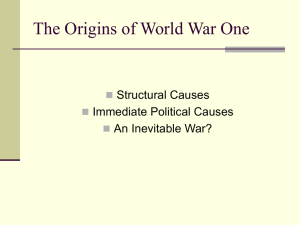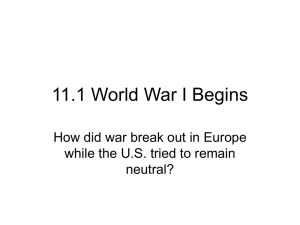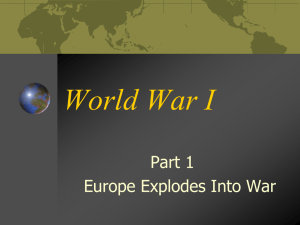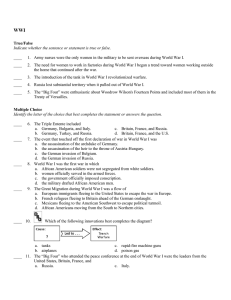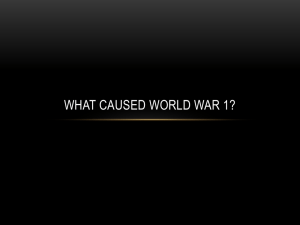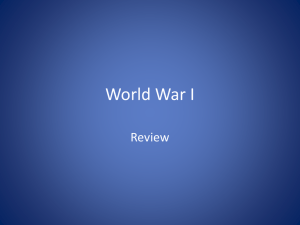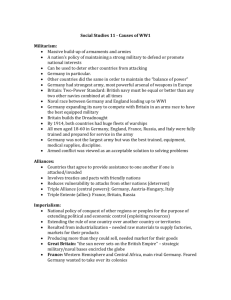CHAPTER 19 - Lone Star College System
advertisement
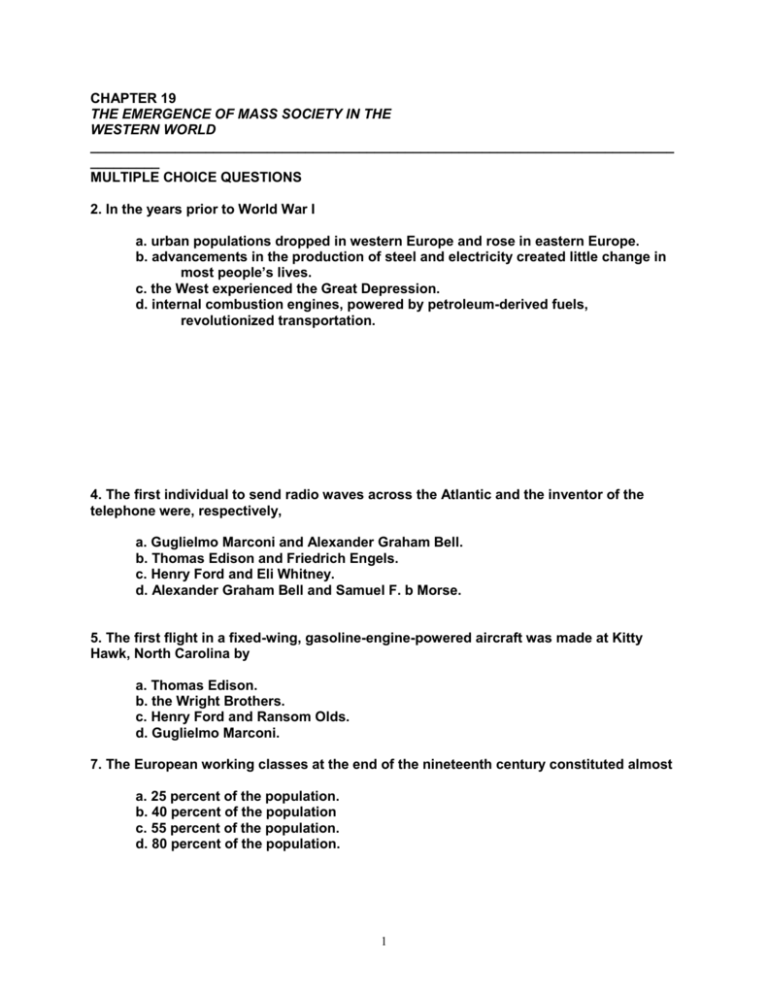
CHAPTER 19 THE EMERGENCE OF MASS SOCIETY IN THE WESTERN WORLD ____________________________________________________________________________ _________ MULTIPLE CHOICE QUESTIONS 2. In the years prior to World War I a. urban populations dropped in western Europe and rose in eastern Europe. b. advancements in the production of steel and electricity created little change in most people’s lives. c. the West experienced the Great Depression. d. internal combustion engines, powered by petroleum-derived fuels, revolutionized transportation. 4. The first individual to send radio waves across the Atlantic and the inventor of the telephone were, respectively, a. Guglielmo Marconi and Alexander Graham Bell. b. Thomas Edison and Friedrich Engels. c. Henry Ford and Eli Whitney. d. Alexander Graham Bell and Samuel F. b Morse. 5. The first flight in a fixed-wing, gasoline-engine-powered aircraft was made at Kitty Hawk, North Carolina by a. Thomas Edison. b. the Wright Brothers. c. Henry Ford and Ransom Olds. d. Guglielmo Marconi. 7. The European working classes at the end of the nineteenth century constituted almost a. 25 percent of the population. b. 40 percent of the population c. 55 percent of the population. d. 80 percent of the population. 1 8. According to Marx and Engels a. class struggle was a recent byproduct of the Industrial Revolution. b. the modern bourgeoisie had been created by recent industrial and commercial events. c. feudal landholders created the agricultural economy of ancient Ethiopia. d. modern governments maintained the interests of the proletariat. 9. Marx claimed that a. after an extended period of educational confrontations, the bourgeoisie would peacefully, adopt a classless governmental and economic system. b. the state, in the 1800s and earlier, was, and long had been, an instrument by which the ruling class imposed its will. c. class conflict had developed only during the Renaissance and Reformation eras. d. a proletarian revolution would, in the future, permit the proletariat to permanently exploit the talents of the bourgeoisie. 10. In the effort to develop adequate housing for Europe’s workers, a. early government efforts in this area were superseded by private housing projects. b. by the 1880s, there was an expansion of the role of government in providing housing. c. city governments ignored this pressing social need in the years before World War I, except in Tallinn and Johannesburg. d. the power of the liberal concept of minimized government produced no public action in this area. 12. The new mass society was characterized by the a. emergence of a new, blended elite of European factory workers and middleclasses who, together, composed about 55 percent of the population. b. creation of new, mass leisure activities to entertain and divert the urban populations. c. development of a working class, comprising 45 percent of the population, whose numbers caused middle-class Europeans to fear a seizure of power by the workers. d. hard-working rural peasant farmers. 13. The Second Industrial Revolution a. reinforced gender-based economic roles. b. created new employment options for women. c. fortified the need for women to remain in the home. d. provided a work environment that diminished women’s job opportunities. 2 15. Of the following nations, which was the first to grant women the right to control their own property? a. Italy. b. Germany. c. Britain. d. France. 16. The first male-dominated occupation to be entered by women was a. architecture. b. teaching. c. jurisprudence. d. manufacturing. 17. An early leader in the drive to professionalize nursing for women was a. Francoise Jourdain in Belgium. b. Amalie Jones in Great Britain. c. Clara Barton in the United States. d. Nora Ibsen in Norway. 19. Which of the following was not an incentive to promote mass education? a. The German policy of restricting literacy to the upper and middle classes. b. The reinforcement of moral values and social discipline. c. The development of a trained workforce. d. The reinforcement of nationalism and its associated loyalties. 21. Professional mass sporting events provided people with a. “bread and circuses,” as both Marx and Bismarck, ironically, noted. b. a direct, participatory role in the events they attended. c. highly organized activities with extensive rules and officials to enforce them. d. professional rugby matches staged by the American League. 22. All of the following were true about Latin America during the late nineteenth century except a. foreign investment increased significantly. b. it was a time of greater prosperity in the region. c. the upper classes throughout the region retained a tight control over political power. d. all Latin Americans participated in the prosperity of the era. 3 23. The Mexican ruler from 1876 to 1910 and the man who overthrew him were, respectively, a. Jaime Cruz and Ernesto Guarracino. b. Porfirio Díaz and Francesco Madero. c. Emiliano Zapata and Pancho Villa. d. Francesco Madero and Bernardo O’Higgins. 24. Emiliano Zapata a. advocated exterminating the Indians in the northern part of the country while serving as Argentina’s “elected caudillo.” b. was the second husband of Florence Nightingale. c. urged his peasant followers to seize the estates of the Mexican elite. d. was a close associate of United States President Woodrow Wilson. 27. United States foreign policy after 1890 a. was characterized by an expansion of American power into the Pacific and the Caribbean. b. led to an extensive war with the population of the Hawaiian Islands. c. was characterized by an unbending adherence to traditional isolationist policies. d. was militarily directed against the French Empire. 28. Wilfred Laurier a. was unsuccessful in developing Canadian industrialization. b. smoothed relations between Canada’s English- and French-speaking populations. c. developed policies that discouraged European immigration into Canada. d. was unable to bring a solution to the problem of French-language education in Canada. 29. The first important American colony was/were the a. Samoan Islands. b. Hawaiian Islands. c. Philippine Islands. d. island of Guam. 31. Which of the following was not included in early twentieth-century British social legislation? a. full-pay pensions for all workers at age fifty-five b. disability insurance c. small pensions for those over seventy d. limited medical insurance 4 32. Which of the following could be considered the most striking contrast between the French and British political systems in the period between 1875 and 1914? a. Britain refused to let women vote while France allowed them to. b. The Third Republic had more political stability than Britain’s constitutional monarchy. c. The multi-party system under the Third Republic produced much less ministerial stability than was the case with the two-party system in Britain. d. Public support for the government was much stronger among the French than among the British. 35. As World War I was about to begin, Austria-Hungary was a. a collection of dissatisfied ethnic minorities held together by an authoritarian ruler. b. a model libertarian democracy. c. ruled primarily by democratic consensus. d. uninterested in events in the Balkans. 36. In Russia, a. the government had effectively won permanent working- and middle-class support by developing a program of social and political reform. b. Alexander III continued the reforms begun by his father. c. Nicholas II disagreed with his father’s attitude toward reform. d. official repression forced some representatives of the growing working class to turn to become revolutionary. 37. The Triple Alliance was composed of a. the Ottoman Empire, Italy and Russia. b. Austria-Hungary, Germany and Italy. c. Austria-Hungary, Germany and Russia. d. Britain, France and Russia. 38. The Triple Entente was composed of a. the Ottoman Empire, Italy and Russia. b. Austria-Hungary, Germany and Italy. c. Austria-Hungary, Germany and Russia. d. Britain, France and Russia. 39. The stage became set for the First World War as a result of the a. conflicts that resulted from major power efforts to control the Balkans. b. four major alliances that established opposing sides in Europe. c. treaty between Germany and Russia established by Bismarck. d. failure of the League of Nations. 5 41. The creator of “relativity theory” was a. Max Plank. b. Albert Einstein. c. Louis Sullivan. d. Enrico Fermi. 42. Freud a. based his ideas on a firm belief in the immutable rationality of human personality. b. challenged the nineteenth century belief in progress with his stress on irrational and unconscious forces operating within a man life. c. advanced the ideas of the id, the wunderkind and the quanta to explain human behavior. d. was the leading European proponent of Social Darwinism. 43. Social Darwinism was given a. a psychological dimension by Sigmund Freud. b. a racial interpretation by Houston Stewart Chamberlain. c. a scientific interpretation by Max Planck. d. an economic interpretation by Adam Smith. 46. Which of the following was an Impressionist artist? a. Berthe Morisot b. Vincent van Gogh c. Gustav Dore d. Pablo Picasso 47. Which of the following pairings is correct? a. Berthe Marisot – Cubist b. Émile Zola – Abstractionist c. Vasily Kandinsky – Abstract d. Gustav Flaubert – Romanticism 50. The European era between 1870 and 1914 can best be described as a. an era of conservatism. b. an era of progress. c. a time of anxiety. d. both b and c 6
